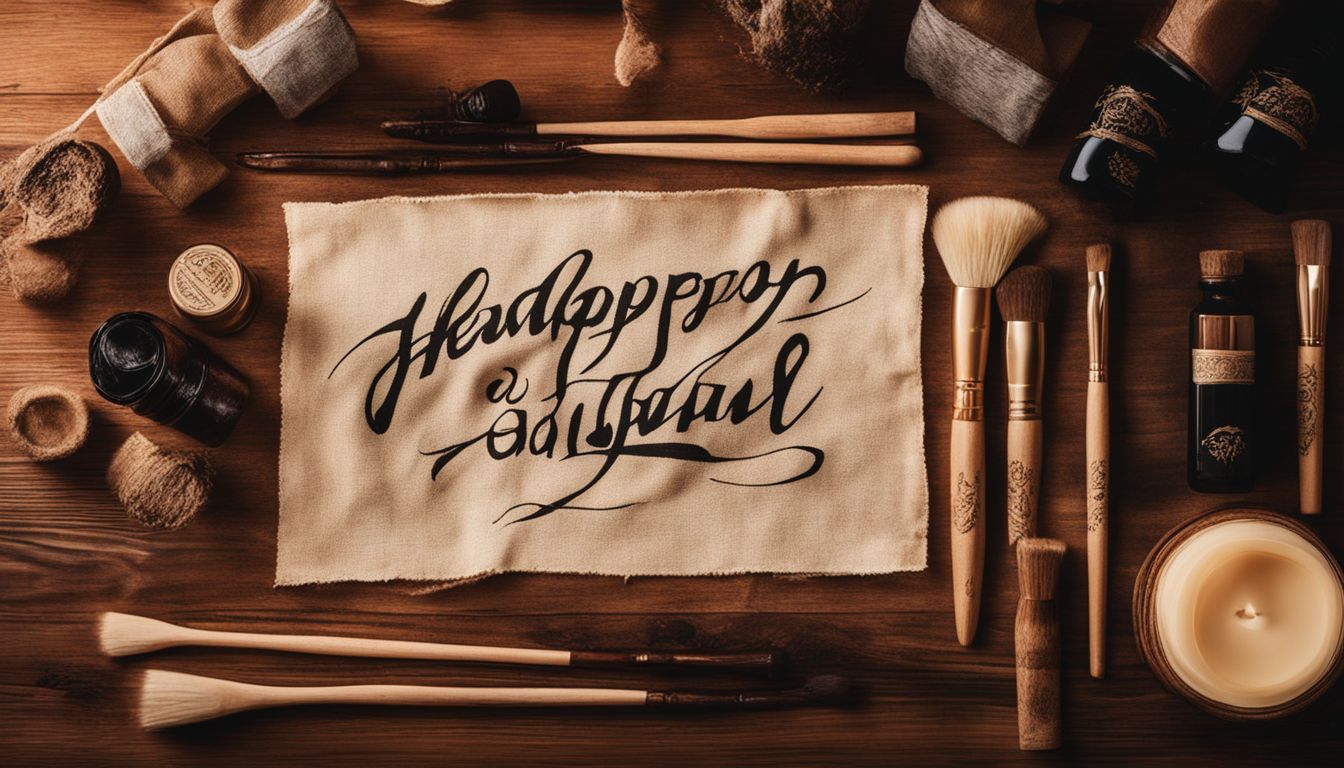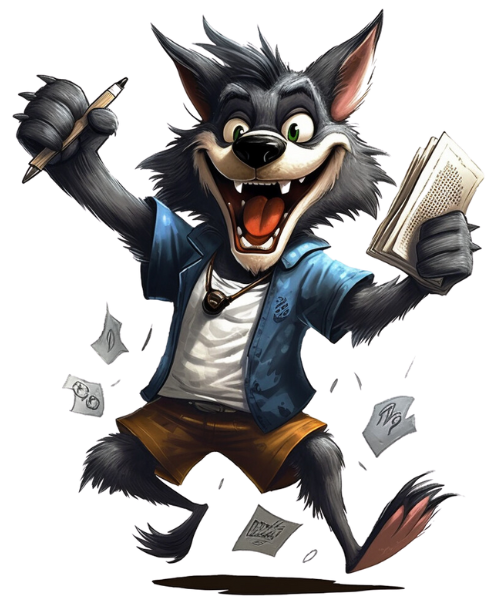Creating a calligraphy banner might seem tough at first. On Etsy, you can find over 3,000 options for these banners. Our article will guide you through selecting materials to designing your masterpiece.
Keep reading for great tips!
Selecting the Right Materials

When choosing materials for your calligraphy banner, consider the type of fabric and the quality of inks and brushes to achieve the desired result. Your choice of fabric, such as cotton or linen, paired with high-quality black fabric ink and suitable brushes will impact the final look of your creation.
Fabric choices: Cotton, Linen, Canvas
Selecting the right fabric is crucial for creating a stunning calligraphy banner. Cotton, linen, and canvas each offer unique benefits that can enhance your project.
- Cotton is lightweight and offers a smooth surface for detailed work. It absorbs ink well, making it ideal for sharp, precise lines. This fabric is also easy to handle and iron, allowing for a neat presentation without unwanted wrinkles or creases.
- Linen brings an elegant texture to your banner. Its natural weave provides a distinctive look that adds depth to your calligraphy. Linen is stronger than cotton and holds up well over time, making it perfect for banners meant to be kept as keepsakes or used in multiple events.
- Canvas stands out due to its durability and heavy-duty quality. It’s the best choice for outdoor banners or ones that need to hang freely without curling at the edges. The stiff fabric supports larger sizes and works well with black fabric ink, ensuring your message stands out clearly against a solid background.
Each material requires specific care; ironing before you start eliminates unwanted folds and using stabilizers can prevent the fabric from moving as you write. When choosing ink, ensure it complements the chosen material – for example, raw, unhemmed edges of canvas might absorb more ink, so planning accordingly will yield the best results.
Opting for a dowel pocket allows easy hanging by inserting a dowel and twine, offering an elegant way to display your work. Finally, always check the care instructions for your fabric to maintain the vibrant look of your calligraphy banner over time.
Choosing the right inks and brushes
Choosing the right inks and brushes is crucial for creating a stunning calligraphy banner. The ink must flow smoothly, and the brushes need to hold their shape to produce beautiful letters.
- Pick water-based inks for their ease of use and quick drying times. These inks work well on fabric banners, ensuring your design doesn’t smudge or bleed.
- Consider acrylic inks for vibrant colors that stand out on any background. Acrylic inks are durable and adhere well to canvas, cotton, and linen fabrics.
- Use high-quality brush pens for script styles requiring fine lines and intricate details. Brush pens offer excellent control, making them perfect for adding custom calligraphy text to your banner.
- Choose broad-edged brushes for block and brush lettering styles. These brushes allow you to create thick, bold lines ideal for making statements on event signage or home decor banners.
- Opt for natural hair brushes if you’re working with traditional calligraphy ink on handmade cotton paper. Natural bristles hold more ink, giving you smooth, uninterrupted strokes.
- Invest in synthetic brushes when using acrylic inks. They won’t swell or lose their shape like natural hair, providing consistent results across different styles.
- Check the stiffness of the brush bristles before purchasing. Stiffer bristles offer more resistance which is great for block lettering, while softer bristles are better suited for scripts that require fluidity.
- Search online reviews or ask fellow artists about their preferred brands and models before placing an order through a web browser or beginning the ordering process.
- Ensure your chosen materials are compatible by doing a small test on a piece of scrap fabric similar to your banner material. This prevents unexpected surprises after you’ve started the final piece.
By following these guidelines and experimenting with different materials, you can find the perfect combination of inks and brushes to bring your vision for a calligraphy banner to life.
Design Techniques and Layouts
Designing a stunning calligraphy banner involves careful planning and skillful execution. Different styles like Script, Block, and Brush require specific techniques to achieve the desired look.
Understanding composition and spacing is vital for creating an aesthetically pleasing design.
Planning your design: Composition and spacing
Crafting a calligraphy banner involves careful planning of design elements and the space they occupy. Good composition ensures your message stands out while proper spacing prevents crowding, enhancing readability.
- Start with a rough sketch: Before touching fabric or ink, create a draft on calligraphy paper. This initial step lets you play with various compositions without commitment.
- Use grid lines for guidance: Drawing grid lines on your draft helps maintain straight lines and equal spacing between letters and words.
- Choose a focal point: Decide on the central element of your banner – this could be a word, phrase, or symbol. Position it in such a way that it catches the eye first.
- Balance text and empty space: Ensure there is enough breathing room around your text. Too little space makes the banner look cluttered, while too much can make it seem incomplete.
- Consider symmetry and asymmetry: Symmetrical designs are visually pleasing and work well for formal occasions. Asymmetrical layouts can add interest and dynamism but require careful balance to avoid looking chaotic.
- Align elements carefully: Alignment doesn’t just refer to centering your text. You can align text to the left, right, or justify for different effects.
- Test color contrasts: On your draft, experiment with different ink colors against your fabric choice to see what stands out best. High contrast improves legibility from a distance.
- Factor in fabric size: Keep in mind the size of fabric you’re working with—both its limitations and possibilities. For larger banners (like 36 x 36 inches), bold scripts work best; smaller pieces may benefit from finer details.
- Leave margins: Always leave ample space around the edges of your design to frame your work nicely and avoid cutting off any part when mounting or hanging.
10.Consider legibility from afar: Larger events or spaces will require bigger lettering and simpler fonts to ensure viewers can read your banner from a distance.
By following these steps when planning your calligraphy banner’s composition and spacing, you set up for creating an eye-catching piece that communicates clearly.
Techniques for different styles: Script, Block, and Brush
When planning your design, consider the different styles of calligraphy you can employ to bring your banner to life. Here are some techniques for utilizing script, block, and brush styles:
- Script Style: This elegant and flowing style is perfect for creating a graceful and artistic look. Utilize a pointed pen with flexible nibs to achieve the smooth and fluid strokes that define the script style.
- Block Style: For a bold and impactful appearance, opt for the block style. This strong and geometric lettering is best executed using broad-edged pens or markers to create sharp, clean lines.
- Brush Style: Achieve a more dynamic and expressive feel with the brush style. Use various types of brushes – such as flat or round brushes – to create varied thickness in your strokes, resulting in a lively and energetic look on your banner.
By employing these different techniques for script, block, and brush styles, you can tailor the appearance of your calligraphy banner according to your specific preferences and design vision.
Personalizing Your Banner
When personalizing your banner, consider incorporating custom text and symbols to make it unique. Adding decorative elements like borders and illustrations can enhance the overall look of your design.
Incorporating custom text and symbols
When incorporating custom text and symbols into your calligraphy banner, consider the following:
- Personalized Messages: Add names, quotes, or greetings to make your banner unique and meaningful.
- Symbolic Imagery: Include symbols such as hearts, stars, or other meaningful icons to convey special sentiments.
- Custom Logos or Monograms: Incorporate personalized logos or monograms for a distinctive touch.
- Special Dates: Commemorate important dates like birthdays, anniversaries, or significant milestones through custom text and symbols.
- Iconic Images: Use imagery that holds significance to the recipient, whether it’s a favorite flower, animal, or hobby-related design.
- Signature Styles: Develop signature calligraphy styles for specific recipients or occasions to create a lasting impression.
- Cultural Emblems: Integrate cultural emblems or motifs that resonate with specific traditions, heritage, or beliefs.
- Nature-inspired Elements: Infuse elements from nature such as trees, mountains, or ocean waves to evoke serenity and beauty in your design.
Adding decorative elements: Borders and illustrations
To further personalize your calligraphy banner, consider adding decorative elements such as borders and illustrations. Here are some design ideas to enhance the visual appeal of your banner:
- Incorporate delicate floral motifs or intricate geometric patterns to frame your calligraphy and add a touch of elegance.
- Use flourishes and scrolls to adorn the edges of your banner, creating a sense of movement and sophistication.
- Experiment with different border styles, such as leafy vines, lace-inspired designs, or bold geometric shapes, to complement the overall theme of your message.
- Integrate small illustrations that align with the text, such as hearts for wedding signage or seasonal motifs for holiday banners, to reinforce the message visually.
- Consider incorporating monograms or personalized emblems within the design to elevate the banner’s significance and make it truly unique.
- Explore diverse color schemes and textures to create visual interest and ensure that the decorative elements harmonize with the calligraphy itself.
- Utilize negative space effectively by strategically placing decorative elements around the text, allowing them to amplify rather than overshadow the calligraphy.
By infusing your calligraphy banner with carefully chosen decorative elements, you can elevate its visual impact and create a captivating piece of art that resonates with its intended audience.
Practical Tips for Calligraphy on Fabric
When creating calligraphy on fabric, make sure to prepare the fabric carefully by ironing and stabilizing it. Also, experiment with different techniques for transferring designs to fabric for a smooth process.
Preparing the fabric: Ironing and stabilizing
To prepare the fabric for calligraphy, start by ironing it to remove any wrinkles and ensure a smooth surface for writing. Stabilize the fabric by using an embroidery hoop or stretching it tightly onto a flat surface such as a table. This will prevent the fabric from shifting while you work on your calligraphy.
- Iron the fabric thoroughly to remove any creases and create a smooth writing surface.
- Use an embroidery hoop to secure the fabric tautly for stability during the calligraphy process.
- Alternatively, stretch the fabric tightly and evenly onto a flat surface like a table to keep it stable while creating your calligraphy banner.
Keep in mind that proper preparation of the fabric is essential for achieving clean and precise calligraphy results.
Techniques for transferring designs to fabric
Transferring calligraphy designs to fabric requires precision and the right tools. Here are some techniques to achieve this:
- Use transfer paper: Place the carbon side down between the design and fabric, then trace over the design to transfer it onto the fabric.
- Carbon paper method: Position the carbon paper under the design and trace over it to transfer the design onto the fabric.
- Freehand tracing: For experienced artists, you can directly trace or draw your design onto the fabric using a water-soluble pen for easy removal if needed.
- Stencil technique: Create a stencil of your design and use fabric paint or ink to transfer it onto the fabric with a brush or sponge applicator.
These techniques provide various options for transferring calligraphy designs to fabric, allowing for creativity and personalized touches in your banner creation.
Inspiration for Calligraphy Banners
Get inspired to create stunning calligraphy banners for various occasions and settings. Explore real-life applications, including event signage, home decor, and personalized gifts.
Wedding and event signage
When it comes to wedding and event signage, custom calligraphy banners can enhance and personalize any occasion. From welcome signs to seating charts, these personalized creations are crafted to elevate the atmosphere of your special day.
With prices ranging from $102.60 for wall hangings to $325.00 for aisle runners, incorporating calligraphy banners into your event decor is not only achievable but also adds an element of sophistication.
For instance, a wedding welcome sign featuring a venue sketch provides a customized touch to reveal the personalized event decor. The details and intricacies of calligraphic designs carefully crafted on cotton fabric showcase direct involvement in the ever-evolving world of event aesthetics.
Home decor and personalized gifts
When it comes to home decor and personalized gifts, calligraphy banners offer a unique touch. Personalized quotes or family names elegantly scripted on linen or cotton can enhance the ambiance of any living space.
The use of high-quality inks ensures longevity, making these banners ideal for gifting on special occasions such as weddings or birthdays. With customizable designs and intricate illustrations, they make for heartfelt presents that add a personal touch to any celebration.
For those looking for more than just off-the-shelf decor options, custom calligraphy banners provide the perfect solution. Whether it’s adding a meaningful quote to adorn a cozy corner or creating custom birthday banners with artistic flair, personalized calligraphy banners are crafted to enhance the visual appeal of any interior space while adding sentimental value to gift-giving occasions.
Conclusion
Crafting a beautiful calligraphy banner entails choosing the right materials, honing design techniques, and customizing the banner to suit your preferences. Helpful suggestions guarantee a seamless execution on fabric, while finding inspiration enhances your creativity.
With more than 3,000 calligraphy banners accessible on platforms such as Etsy, this artistic form presents limitless opportunities for gatherings and home embellishments. Let your creativity flourish as you delve into the world of calligraphy banners – an ever-changing canvas for individualized expression and jubilation!
FAQs
1. What should I do if the page I was searching for content on calligraphy banners is deleted?
If you find that a page with tips and inspiration for creating stunning calligraphy banners has been deleted, try to search elsewhere online or consider reaching out to experts in the field.
2. Can I still access the information if the page about creating a stunning calligraphy banner has moved?
Yes, usually when a page moves there will be a redirect link provided. If not, use your search engine again and type in relevant keywords like “stunning calligraphy banner” or “calligraphy banner tips”.
3. How can I find good content about making beautiful calligraphy banners?
You can start by searching for content using specific phrases related to your interest such as “creating stunning calligraphy banners”, “calligraphy design inspiration”, or even more specific terms based on what exactly you’re looking for.
4. What happens when the webpage with my favorite inspiring tips about creating a stunning calligraphy banner gets deleted?
When pages get deleted it may seem like all hope is lost but don’t worry! You can always perform another search using similar keywords to find other resources that offer great advice and inspiration for crafting amazing calligraphic displays.




Leave a Reply
You must be logged in to post a comment.